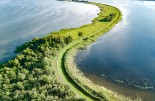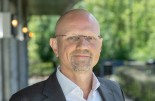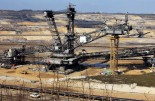Impact measurement and risk management in investments (Roundtable Natural Capital - part 3)
Impact measurement and risk management in investments (Roundtable Natural Capital - part 3)

This report was originally written in Dutch. This is an English translation.
The impact of natural capital solutions is often difficult to express in monetary terms. Nevertheless, measuring impact is essential, as is risk management. In part 3 of the Round Table on Natural Capital, participants considered the materiality and risks of investing in nature.
By Hans Amesz
This is part 3 of the report. Part 1 can be read here, part 2 can be read here.
|
Moderator Sanne van Gorp, PGGM
Participants Céline Claudon, IWC (meerderheidsbezit van BNP Paribas Asset Management) Jérôme Dulong, AXA IM Alts Sébastien Duquet, Mirova (onderdeel van Natixis Investment Managers) Arnold Gast, Morningstar Sustainalytics Ralf Kooken, a.s.r. real assets investment partners Mark de Nooij, MN |
How do you assess the materiality of your interventions, both for nature-based solutions and for identifying existing risks in advance, and how do you address those risks?
Duquet: 'It's quite specific for us. Each fund has its own metrics and approach to measuring pre- and post-investment impact. These differ, for example, for our sustainable ocean, sustainable agriculture, carbon credit and energy transition strategies. Every investment has its own characteristics. We always look at the situation before the investment and compare it with the situation afterwards. We then draw up specific measurement indicators tailored to each sector. Take, for example, an investment in the energy transition, such as solar energy systems for small-scale farmers. We measure how much CO2 emissions are avoided. First, we calculate how much emissions there were with traditional means (such as kerosene lamps) and then what the emissions are after the installation of solar panels. We also take into account the national climate targets, the so-called NDCs, and how they are developing. Because what applies now may be different in eight years' time, depending on a country's energy mix. We do something similar for biodiversity. For example: how many hectares of land have been restored? Or how many hectares are being managed sustainably for agriculture? We check this using both satellites and site visits. Our agricultural and impact teams inspect everything on site before the investment and monitor it throughout the entire duration of the investment. It is crucial, especially in sustainable agriculture and carbon investment projects, that local communities are involved and remain involved. Long-term engagement can only succeed if local communities benefit from it in terms of additional income, improved agricultural methods, and so on. To ensure the quality of our data, we work with external auditors, such as the company I Care. They check our methodologies and the figures we report, such as the CO2 emissions avoided or captured. Sometimes we have to make assumptions, and we want to be sure that these stand up to scrutiny. We do our best to strive for high quality, but we also recognise that others may think differently. This means that we remain open and pragmatic and regularly review our methodologies. The figures may even change during the term of a fund. This is because the world is changing, which brings with it new insights, new reporting methods and better data. We are constantly learning. We must be transparent, open to criticism and willing to undergo audits.'
Gast: 'That is also our challenge. We prefer to keep methodologies consistent over time, but the world is changing. We are gaining better insights and better reporting and have to process that. That is difficult, because investors want consistency. So sometimes we have to stick to old reports, while also including the new ones. That makes the research work increasingly extensive.'
De Nooij: 'Even if you try to do everything right, sometimes the data just doesn't look very good. To give an example: if we buy a piece of land with an old forest on it, there is a lot of CO2 stored there. But to turn it into a healthy, ecologically valuable forest, trees first have to be cut down. This temporarily reduces the CO2 level, and then many people think: what are you doing? But that is a long-term strategy. There is more than just a single number; it's not just about the amount of CO2. There is a story behind it, and that is precisely the point. Forest owners store CO2 in wood that is ultimately used for housing. The question then is who can claim that CO2 storage. The owners of the forest where the wood comes from, or the person who bought the piece of wood and is now using it in their home? This 'double accounting' is incredibly difficult.'
Dulong: 'It's all about our assessment criteria, our 'underwriting'. We have to be conservative in our approach because knowledge, data and methodologies are constantly changing. No one knows what will happen in a few decades. Ideally, you would monitor every tree, how it grows, how long the wood remains in a structure, and so on. Unfortunately, we cannot do that yet, so we have to make the most honest estimates possible and be transparent about them to all stakeholders.'
Investments in natural capital often involve unique risks, such as regulatory changes or climate volatility. How do you manage risk and still achieve competitive returns?
Kooken: ‘Broad diversification across crop types, sectors, markets, etc. is essential. Many risks can be partially assessed on the basis of historical data. By combining historical data with future scenarios, you can manage risks more effectively. However, climate change is still insufficiently reflected in historical data, even though it will significantly change cultivation, growing conditions and the landscape. A large part of the sector focuses on permanent crops, and California is important in that respect. In the past, high returns have been achieved there with almond and pistachio plantations, among other things. However, too much water has been pumped out of the ground in that region, more than is replenished annually. In 2014, California responded by introducing the Sustainable Groundwater Management Act. As a result, there are now quite a few plantations with weak or even no water rights, which has significantly reduced the value of those properties. It is therefore crucial to look at future climate risks. We use various methods to do this. Together with a partner, we look at the climate risks and adaptation options at the environmental and property level over different time periods. This gives us a better understanding of the long-term risks and opportunities of a forestry or agricultural project.'
Claudon: 'When managing risks, specifically for natural capital, diversification is essential, not only in terms of geography, but also in terms of species, markets and end products. Due diligence is very important. Even within a single region, the quality of assets can vary greatly. You choose the best piece of land that fits your strategy, depending on whether you are more focused on return, risk or impact. For us, with real physical assets, natural risks are important. When we looked at damage caused by hurricanes, forest fires, insect infestations, diseases, droughts, floods, ice storms, etc., we saw an average loss of less than 0.2% per year over a portfolio of fourteen billion dollars over eight years. That is relatively limited, but the impact on a single asset can of course be significant. That is why insurance is important, even though you cannot take it out everywhere and at all times. In addition, we always carry out a climate risk and opportunity analysis for each asset. Then it is a matter of active management, adapting to changing circumstances.'
How do you work with other organisations or governments to increase the impact of your natural capital investments? Can you give examples of successful collaborations?
De Nooij: 'We are working on conservation easement projects, together with forestry services and other government agencies in the United States. These are extremely valuable for our investors, for biodiversity, for the climate and for the United States itself.'
Duquet: 'We try to actively build coalitions and partnerships in all our sectors. In forestry, we recently announced a collaboration with FSC, the Forest Stewardship Council. We encourage all our participating companies to obtain certification, for example through Rainforest Alliance. This is important because it shows that a party has grown in terms of sustainability. It also helps to have external verification: are they really working sustainably, or does it just look that way? In addition, certification can generate additional income, for example for small farmers who grow certified cocoa or coffee. The same applies to FSC-certified wood. In addition, we work with data agencies to strengthen our analyses and impact measurements. We have entered into several such partnerships to further substantiate our vision of impact. Thirdly, we are actively involved in coalitions and industry organisations, such as the TNFD, the Taskforce on Nature-related Financial Disclosures. We have been part of a working group within the TNFD for many years and actively contribute to its work. Dulong: ‘When it comes to forestry, certification is crucial. All our forests are FSC or PEFC certified, and we strive to maintain dual certification. This ensures that we fully cover biodiversity, carbon storage and sustainable management.'
Dulong: 'Forest management consists of multiple layers. You have the end investors, ourselves as investment managers, and the forest manager on site. On top of that, you often work with local parties and NGOs. If you manage to activate all those layers and get them on the same page, you create a powerful ecosystem. By encouraging collaboration, everyone performs better. In Finland, we have a project where we work with a paper manufacturer. We improve forest management, ensure that all paper is FSC-certified, and that everything that happens in the forest actually meets the standard and our internal requirements. The paper manufacturer's factories are designed to use everything from the forest, as close to the source as possible, so that transport is kept to a minimum. In emerging markets, as I mentioned earlier, we work with local communities, NGOs and governments. We focus in particular on revenue sharing and benefits for the local population. Together with NGOs, for example, we have set up women's clinics in the communities themselves. By working together with local communities, the government and NGOs that provide funding and coordination, we bring the entire ecosystem together. This not only has a social impact, but also financial benefits for the project. Finally, I would like to mention an example of how we invest in the entire value chain. We have acquired a stake in a company, Chloris Geospatial, which collects nature data via satellite imagery. Among other things, they measure biomass prior to our investment, during the project and after its completion. This allows us to accurately determine how much CO2 has actually been captured by tree growth. We can also detect 'leakage', such as deforestation in the immediate vicinity. And we can assess whether there is real additionality, i.e. whether the project delivers something that would not otherwise have happened. This approach enables us to create value through the quality of the CO2 credits, through the ecosystems that are delivered and through potential follow-up investments. Because we are a shareholder in the project developer, co-finance the project and are involved in land acquisition, we can unlock value along the entire value chain.'
Finally, do you have any closing remarks?
Dulong: 'In the current volatile macroeconomic environment with regard to government policy, it is a reassuring sign that capital from the private sector is moving in the right direction. So let's remain positive and believe that we will make the right decisions over the next twenty to thirty years, with an even longer positive impact.'
Kooken: 'What we haven't touched on is the increasing use of engineered wood products such as cross-laminated timber (CLT) and laminated wood (glulam) in construction projects as a substitute for concrete and steel. This wood stores CO2 and is used in buildings, where the CO2 remains stored for a long time. At the same time, you avoid the production of steel and concrete, which is very polluting. I am seeing this more and more in the United States. But there are also more projects in the Netherlands where this is being used. This is a promising trend, both from a sustainability and a financial perspective.'
Duquet: 'Climate change is having a major impact on nature, but there are solutions. As the effects of climate change are becoming increasingly visible, I think we will move faster. We also have a growing understanding of the value of natural systems. If we can capture that value – through CO2 credits, protection, etc. – then the whole paradigm of financial investment will change.'
Guest: 'It’s fantastic to see that private investments with a positive impact on natural capital are so well developed. However, these investments only make up a small part of investment portfolios. Knowing that our natural environment can recover quickly, we must also continue to reduce the negative impact of listed companies.'
Claudon: 'There are several things working in our favour. First, the willingness to invest. More and more people are aware that natural capital investments contribute to solving the crises of climate change and biodiversity loss. Second, the revenue side. New revenue streams and attractive returns are emerging. Third, technology. AI, remote sensing and blockchain are huge steps forward for our sector. And finally, regulation. There is an increasing regulatory framework in place that supports the natural capital asset class.'
|
SUMMARY Natural capital encompasses the natural resources and ecosystem services provided by the Earth that are essential to our lives and well-being, such as forests, water, soil, air and raw materials. This asset class is still relatively new in the institutional world. It is growing, partly due to sustainability considerations and its low correlation with traditional assets. Natural capital is a stable factor in the investment portfolio. The relatively high returns and low risks contribute to a high Sharpe ratio. Investors really need to take a long-term view on natural capital. The impact of natural capital solutions is often difficult to express in monetary terms. More and more investors are aware that investments in natural capital contribute to solving problems such as climate change. |
|
Sanne van Gorp Sanne van Gorp works as an Investment Strategist in PGGM's Strategy Department. In her role, she advises PFZW on the fund's sustainable investment policy, drawing on her academic background in both finance and sustainability. She is working on the development of PFZW and PGGM's new impact strategy, which actively focuses on real-world impact. |
|
Céline Claudon Céline Claudon is Chief Commercial Officer at International Woodland Company (IWC), a specialist in natural capital. She has 20 years of experience in investing in natural capital, including evaluating portfolio managers for IWC's institutional clients. BNP Paribas Asset Management has a majority stake in IWC. |
|
Jérôme Dulong Jérôme Dulong is Head of Natural Capital Investments at AXA IM Alts and focuses on nature-based solutions and forestry. He is primarily responsible for the deployment of the AXA IM Natural Capital Fund, which was established with a $500 million investment by the AXA Group and invests globally in nature conservation and restoration projects. |
|
Sébastien Duquet Sébastien Duquet is Head of DFI & Sovereign Business at Mirova (part of Natixis Investment Managers). He develops private funds for development finance institutions and foundations, with a focus on energy transition and natural capital. Previously, he was CIO at Symbiotics. Duquet has also led Oxus and PlaNIS. He is co-founder of FinanCités and Planet Guarantee and has worked at Arthur Andersen and EY. |
|
Arnold Gast Arnold Gast joined Morningstar Sustainalytics in 2022, where he currently leads the ESG Sector Research team. This team consists of approximately 90 research analysts who provide company-level ESG ratings that assess risks, controversies and climate change impact. Previously, Gast worked at Shell Pensioenbureau Nederland, ILX, ACTIAM and Delta Lloyd Asset Management, among others. |
|
Ralf Kooken Ralf Kooken focuses on global infrastructure and natural capital investments in which a.s.r. real assets investment partners invest on behalf of its clients. He develops investment strategies and is responsible for the implementation and management of these investments. Kooken has extensive experience, both in the Netherlands and internationally, and is skilled in developing sustainable investment strategies, formulating net-zero policies and conducting climate scenario analyses. |
|
Mark de Nooij Mark de Nooij has an educational background ranging from Electrical Engineering at Delft University of Technology to General Management at Nijenrode Business University. He began his professional journey as an Engineer at Wartsila, followed by a move to MN, where he started working as an Investment Strategist. At NZ-Funds in New Zealand, he flourished as a Portfolio Manager. He has been back at MN since 2012. |

















